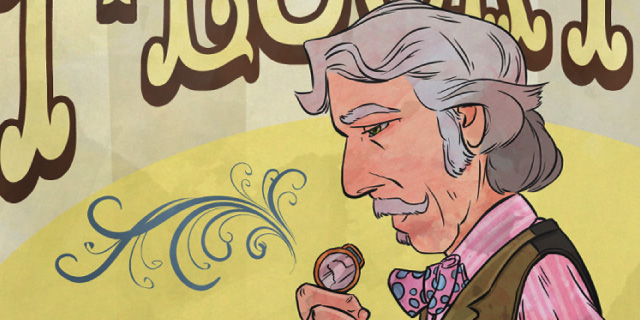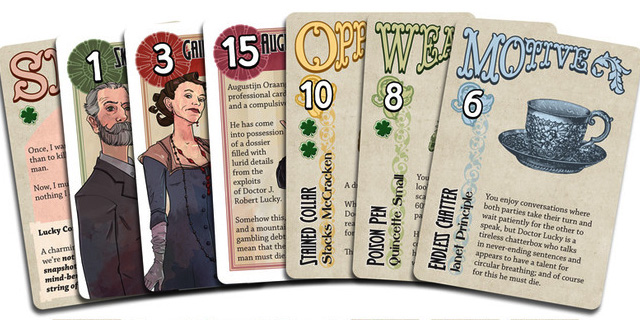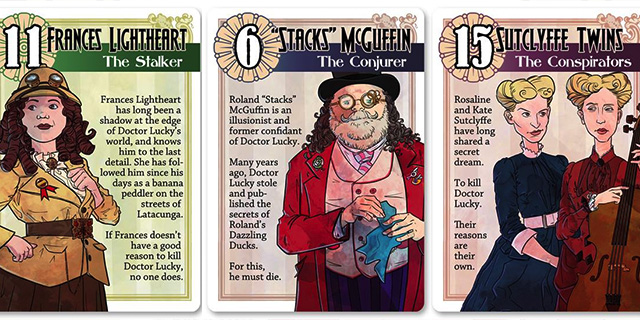
One of my very first Unplugged columns covered the deluxe version of Cheapass Games mainstay Kill Doctor Lucky. I’ve been a fan of James Ernest’s quirky game design philosophy for a while now, but my only experience with one of his flagship titles was not a favorable one due to one or two problems that really dragged it down. Fortunately, a new card-only version of KDL has eliminated these and made casual homicide fun again.
In Get Lucky, your goal is still to kill Doctor Lucky as he wanders from room to room. However, there is no board in this version, and instead he moves directly from character to character. Each player (up to six) controls two of the 15 would-be assassins, with three more placed in a central “drawing room” and any remainder set aside unused. These characters are numbered from one through 15, and Doctor Lucky hops around the table in numerical order. Characters not being used are skipped, but those in the drawing room are not. On these turns, players (starting with the most recently active) may draw one card as long as their current hand size is lower than the character’s turn order number.
When the Doctor is visiting one of your characters, it is your turn, and you may execute one of four simple actions. The most basic is to simply draw a card. Most of the cards represent either a Motive, a Weapon or an Opportunity that will aid a character in their mission. You may play one of these cards on to one of your characters as an action, which will help you when you later take the third possible action, trying to kill the Doctor with the active character.

Each character has a base value of one, plus one for each upgrade attached to that character. Note that each upgrade has a number on it, indicating the “perfect motive/opportunity/weapon” for that character and bestowing a plus two bonus instead, to a maximum of seven since a given character can only have one of each upgrade. Once the attack value is determined, it is up to the other players to thwart the attempt.
Most upgrade cards also feature one or two luck icons. Discarding one or more of these will reduce the current attempt’s value by one per symbol. Also in the deck are Spite cards; in addition to acting as one luck, played Spite cards become permanently attached to that character and reduce all future attempts by one per attached Spite. If a character’s attack value is brought down to zero — or if one of their “perfect” upgrades is discarded by another player — their attempt fails and Doctor Lucky moves on.
The final option is to swap a character (and everything attached to them) for one of the characters in the drawing room. This is useful if one of your characters has built up too much Spite or if your hand has a lot of perfect upgrades for one of the new characters. It can also be used to adjust when your turns come up, which may have strategic benefits.
An important rule to consider is that kill attempts must be countered if at all possible. Since each player only gets one chance to discard cards or pass, this burden ultimately falls to the player to the right of the active player. While holding back can be a rewarding strategy to run an opponent out of cards, you have to weigh the risk that they might not have enough Luck to stop the current attempt and thus end the game. Since the deck is never reshuffled, eventually the old boy’s famous luck will run out and a player will successfully kill Doctor Lucky and win the game.

As with most Cheapass designs, Get Lucky is less about the actual game mechanics and more about the brilliant humor worked into them. In a more serious game, each card would have probably just been a name, a number and an illustration. Get Lucky sets the mood by putting a paragraph or two of hilarious text on each card, explaining its application to the task at hand. If you go through the game just stoically playing cards and playing chicken, it’s going to get old fast, but the game won’t last much longer than 20 minutes, so even that isn’t too terrible. If, instead, you dramatically read out each card’s text as you play it, you might extend the play time by about five minutes total but have a much better experience. How you actually play is up to you, but if you don’t have fun playing, you’re kind of missing the point.
With neither the positional complications found in the original nor the tedious Spite-token endgame of the Deluxe Edition, Get Lucky is perhaps the best iteration of the Kill Doctor Lucky formula. It plays fast, the humor is great, and retails for under $20. As fillers go, you can’t really ask for more than that.



















